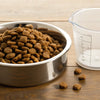How Much Hamburger and Rice for Dog by Weight lb: A Comprehensive Guide
- Houndsy
Table of Contents
- Introduction
- Understanding a Bland Diet
- Determining the Right Amount of Hamburger and Rice
- Preparing Hamburger and Rice for Your Dog
- Transitioning Back to Regular Diet
- The Role of Houndsy in Feeding Routines
- Conclusion
- FAQ
Introduction
As devoted pet owners, we often find ourselves in situations where our furry friends might not be feeling their best. One common concern is when our dogs experience digestive issues, particularly diarrhea. In these instances, many of us turn to a bland diet of hamburger and rice, but how much should we serve based on our dog’s weight? According to veterinarians, providing the right proportions of food can significantly aid in recovery and comfort.
In this blog post, we will delve into effective feeding practices for dogs recovering from digestive upset, particularly focusing on the optimal amounts of hamburger and rice based on your dog's weight in pounds. We will explore the benefits of a bland diet, how to prepare it, and how to transition back to a regular diet. By the end of this article, you will have a clear understanding of how to better support your dog during times of digestive distress, ensuring they receive the care they need in a convenient and effective manner.
As we navigate through this essential topic, we invite you to reflect on your own feeding routines and consider how these insights could enhance your beloved pet's dietary experience. Let’s embark on this journey to better understand how much hamburger and rice for dogs by weight lb is appropriate, and how we at Houndsy can support you through the feeding process with our innovative design and products.
Understanding a Bland Diet
What is a Bland Diet?
A bland diet is specifically designed to soothe an upset stomach and is typically low in fat, fiber, and protein while being high in easily digestible carbohydrates. This type of diet is often recommended for dogs experiencing gastrointestinal issues such as diarrhea, vomiting, or other digestive disturbances. The main goal of a bland diet is to provide nutrition without further irritating the digestive system.
Why Hamburger and Rice?
Hamburger and rice are two of the most commonly recommended foods for bland diets. They provide a good balance of protein and carbohydrates while being easy on the stomach.
- Hamburger: It's essential to choose lean ground beef, as this helps minimize fat intake, which can exacerbate digestive issues.
- Rice: White rice is easy to digest, making it an ideal carbohydrate source for dogs recovering from stomach upset.
Together, they create a comforting meal that most dogs will find appetizing.
Benefits of a Bland Diet
- Easier Digestion: The simplicity of the ingredients leads to less strain on the digestive system.
- Reduced Inflammation: Bland diets help reduce irritation in the stomach and intestines.
- Nutritional Support: They provide essential nutrients without overwhelming the system.
- Hydration: Boiling the hamburger and rice allows for moisture retention, which is crucial if a dog is dehydrated from diarrhea.
Determining the Right Amount of Hamburger and Rice
Portion Guidelines Based on Weight
When it comes to serving your dog, the appropriate amount of hamburger and rice varies depending on their weight. Here’s a general guideline to follow:
- Dogs weighing less than 5 pounds: Approximately ½ cup of the mixture per day.
- Dogs weighing 5 – 15 pounds: Approximately ½ to ¾ cup per day.
- Dogs weighing 16 – 30 pounds: Approximately 1 to 1 ½ cups per day.
- Dogs weighing 31 – 50 pounds: Approximately 1 ½ to 2 cups per day.
- Dogs weighing 51 – 75 pounds: Approximately 2 to 3 cups per day.
- Dogs weighing 76 – 99 pounds: Approximately 3 to 4 cups per day.
- Dogs weighing over 100 pounds: Approximately 4 to 5 cups per day.
These portions should be split across multiple meals throughout the day—ideally, four to six smaller meals to aid digestion.
Practical Example
For instance, if you have a dog weighing 30 pounds, you would prepare about 1 to 1 ½ cups of the hamburger and rice mixture for the day. To start, you might serve ½ cup at a time, allowing for two to three hours between each meal. Monitoring your dog’s response is essential, as you may adjust portions depending on their improvement.
Preparing Hamburger and Rice for Your Dog
Cooking Instructions
- Select Lean Ground Beef: Choose a lean ground beef option, like sirloin or extra-lean ground beef, to minimize fat.
- Cook Thoroughly: Boil or steam the hamburger until well-cooked, draining any excess fat. Avoid adding seasoning or spices, as these can irritate your dog's stomach.
- Prepare Rice: Cook plain white rice according to package instructions. Avoid using any oils or flavorings.
- Mix Together: Combine the cooked hamburger and rice in a 1:1 or 75% rice to 25% hamburger ratio—depending on your dog's needs and preferences.
Storage Tips
Once prepared, you can store the mixture in the refrigerator for up to 72 hours. Just be sure to warm it slightly before serving, as this can make it more appealing to your dog.
Transitioning Back to Regular Diet
Timetable for Transition
After your dog has been on the bland diet for a few days and shows signs of improvement, you can begin to transition back to their regular food. Here’s a suggested timeline:
- Days 1-3: Stick strictly to the bland diet. Monitor your dog's stool and overall condition.
- Days 4-5: Begin to mix in their regular dog food with the bland diet, gradually increasing the regular food percentage while decreasing the bland diet.
- Days 6-7: By day seven, most dogs should be able to return to their regular diet, provided their stools are firm and they show no signs of distress.
Signs to Watch For
Keep a close eye on your dog during this transition. If diarrhea returns or your dog displays any signs of lethargy, vomiting, or discomfort, consult your veterinarian for further guidance.
The Role of Houndsy in Feeding Routines
At Houndsy, we recognize that feeding your pet can sometimes feel overwhelming, especially during times of illness or dietary changes. Our flagship product, the Houndsy Kibble Dispenser, is designed to simplify and elevate the dog-feeding experience. With features that promote perfect portion control, ergonomic convenience, and a design that complements modern home decor, the Houndsy Kibble Dispenser helps make feeding less messy and more enjoyable.
Imagine effortlessly dispensing the right amount of food, without bending down, while still keeping your kitchen stylish. If you’re interested in enhancing your feeding routine, we encourage you to explore the Houndsy Kibble Dispenser here.
Conclusion
In summary, understanding how much hamburger and rice for dogs by weight lb is essential for supporting our pets during digestive upset. By following the recommended portion guidelines, preparing the food correctly, and transitioning back to their regular diet thoughtfully, we can help our dogs recover swiftly and comfortably.
We hope this guide has provided you with valuable insights that can improve your pet’s feeding experience during challenging times. If you have any questions or want to share your own experiences, please feel free to reach out. And remember, when it comes to making feeding easier and more enjoyable, the Houndsy Kibble Dispenser is here to help. Consider giving it a try today.
FAQ
1. Can I use other meats instead of hamburger? Yes, you can use other lean meats like boiled chicken or turkey. Just ensure the meat is low in fat and free from seasoning.
2. How long should I keep my dog on a bland diet? Typically, a bland diet is recommended for 3 to 5 days, depending on your dog’s condition and recovery.
3. What if my dog doesn’t like hamburger and rice? If your dog refuses to eat the bland diet, consult your veterinarian. They may recommend alternative bland foods or prescription diets tailored to your dog’s needs.
4. Can I give my dog treats while on a bland diet? It’s best to avoid treats during the bland diet period, as they can irritate the stomach and interfere with recovery.
5. How can I tell if my dog is improving? Monitor your dog's stool consistency and overall energy levels. Improvement is typically indicated by firmer stools and a return to normal behavior. If you have concerns, consult your veterinarian.












